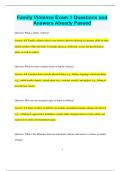Family Violence Exam 1 Questions and
Answers Already Passed
Question: What is family violence?
Answer: ✔✔ Family violence refers to any abusive behavior directed at a partner, child, or other
family member within the home. It includes physical, emotional, sexual, and psychological
abuse, as well as neglect.
Question: What are some common forms of family violence?
Answer: ✔✔ Common forms include physical abuse (e.g., hitting, slapping), emotional abuse
(e.g., verbal insults, threats), sexual abuse (e.g., coercion, assault), and neglect (e.g., failing to
provide basic needs).
Question: How can one recognize signs of abuse in children?
Answer: ✔✔ Signs of abuse in children can include unexplained injuries, changes in behavior
(e.g., withdrawal, aggression), fearfulness around adults, frequent absences from school, and
regression to earlier developmental stages.
Question: What is the difference between situational violence and coercive violence in family
settings?
1
,Answer: ✔✔ Situational violence occurs in specific contexts or situations, often as a result of
conflict or stress, while coercive violence involves a pattern of control and manipulation aimed
at maintaining power over a partner or family member.
Question: What are the primary reasons victims of family violence may not report the abuse?
Answer: ✔✔ Victims may not report abuse due to fear of retaliation, shame, financial
dependence, concerns about child custody, lack of trust in authorities, or uncertainty about
available support services.
Question: What strategies can be effective in preventing family violence?
Answer: ✔✔ Effective prevention strategies include public education campaigns, promoting
healthy relationships, providing support for at-risk families, offering parenting classes, and
advocating for policy changes that protect victims.
Question: How does exposure to family violence impact adult victims psychologically?
Answer: ✔✔ Adult victims may experience symptoms of post-traumatic stress disorder (PTSD),
anxiety, depression, low self-esteem, and difficulty forming or maintaining healthy relationships
as a result of exposure to violence.
Question: What role do community organizations play in addressing family violence?
2
, Answer: ✔✔ Community organizations provide essential services such as shelters, counseling,
legal assistance, and advocacy. They work to raise awareness, support victims, and advocate for
systemic changes to prevent and address family violence.
Question: How can healthcare professionals identify signs of family violence?
Answer: ✔✔ Healthcare professionals should be alert to signs such as unexplained injuries,
inconsistent explanations for injuries, signs of emotional distress, and behavioral changes. They
can provide support by screening, offering resources, and making referrals to appropriate
services.
Question: What are the key components of a safety plan for individuals experiencing family
violence?
Answer: ✔✔ A safety plan should include identifying a safe place to go, having an emergency
bag ready, setting up a code word or signal with trusted individuals, and developing a plan for
escaping the home safely.
Question: What is the role of legal protection orders in family violence cases?
Answer: ✔✔ Legal protection orders, such as restraining orders, legally prohibit the abuser from
contacting or approaching the victim. They provide a means for victims to seek legal protection
and involve law enforcement if the order is violated.
3




